 For my 2020 reading endeavors, I set a special goal to DECOLONIZE my reading list, especially upon realizing that most of the 43 books I read in 2019 happened to be written by straight, cis, white men. So despite considering books to be my most valuable source of information, especially in our wonky news media world, it also seemed that this source of knowledge was rather biased as it lacked the voice and perspectives of women, people of color, and those from other marginalized groups of people – rather ironic as I myself fall into this category.
For my 2020 reading endeavors, I set a special goal to DECOLONIZE my reading list, especially upon realizing that most of the 43 books I read in 2019 happened to be written by straight, cis, white men. So despite considering books to be my most valuable source of information, especially in our wonky news media world, it also seemed that this source of knowledge was rather biased as it lacked the voice and perspectives of women, people of color, and those from other marginalized groups of people – rather ironic as I myself fall into this category.
So for 2020, in order to expand the scope of authors I was exposed to, I made a rule to simply exclude one category of authors: cis, straight, white men. And it turned out that it’s not easy to get around an overrepresented and dominant group. But I managed by expanding beyond my typical genres of sciences and personal development to other forms of writing, including fiction and memoirs, totaling 31 books for the year. And what I found in this new assortment of authors was nothing short of an incredible richness in storytelling, setting, and perspective. And despite being engulfed in a greater breadth of new worlds and narratives, for the first time I felt rather comfortable in these spaces. Simply because the voices sounded a lot like my own. That the subconscious feeling of alienation, as a person from a marginalized background, didn’t apply anymore as I was among others like me. What a discovery!
Below’s the near full list of books in the order I read them (I left off two as they were of a very personal nature). And some quick stats regarding these 29 books:
– 8 authors of South Asian descent
– 10 authors of East Asian descent
– 8 authors are African American
– 18 (more than half) by women
– 20 were fiction
Educated, by Tara Westover
 This book is a stunner and gripping one. It’s the story of a woman who grew up in the Idahoan mountainside in a household that held deep survivalist and conservative beliefs. Due to her father’s mistrust of institutions, she and all of her six siblings hardly attended school if at all and had all medical issues treated with herbalism at home. The real kicker is that this book is a memoir – reality is stranger than fiction for sure – and left me astounded in so many ways. For one, how everyone remained alive given the lack of medical treatment especially as much of the family did scrap metal and construction work through methods that would give an OSHA supervisor a heart attack. But more so that there’s so many relatable themes to unpack and digest: a power dynamic where the word of the father is law; choosing between one’s family and one’s future; contrasting family values against being “normal”; mental health and abuse; and especially what goes on in the mind of women in a world where men have all the power. This piece marvelously captivating, profoundly vulnerable, and poetically written.
This book is a stunner and gripping one. It’s the story of a woman who grew up in the Idahoan mountainside in a household that held deep survivalist and conservative beliefs. Due to her father’s mistrust of institutions, she and all of her six siblings hardly attended school if at all and had all medical issues treated with herbalism at home. The real kicker is that this book is a memoir – reality is stranger than fiction for sure – and left me astounded in so many ways. For one, how everyone remained alive given the lack of medical treatment especially as much of the family did scrap metal and construction work through methods that would give an OSHA supervisor a heart attack. But more so that there’s so many relatable themes to unpack and digest: a power dynamic where the word of the father is law; choosing between one’s family and one’s future; contrasting family values against being “normal”; mental health and abuse; and especially what goes on in the mind of women in a world where men have all the power. This piece marvelously captivating, profoundly vulnerable, and poetically written.
The Majesties, by Tiffany Tsao
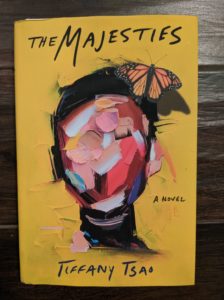 This novel appears cast as the dark side behind something of a “Crazy Rich Asians” story as it’s about an extended family consisting of ultra wealthy Chinese living in Indonesia. However, it goes so much deeper (well at least compared to the movie as I haven’t yet read the “Crazy Rich Asians” book series). The story centers on two sisters and is told from the perspective of one of them as she slingshots through memories across various points in time to slowly unravel the path their lives took leading to an ultimately tragic moment. The author delves into a number of themes including domestic abuse and the power structures women are relegated to, classism and racism, balancing family desires against ones own, and finding oneself too deep into a situation with no way out. Some readers might argue that the overall story falls a bit flat and while I wouldn’t disagree, I also don’t think it matters as the details in the themes are well drawn out gems. Either way, I couldn’t put this book down as it left me hungry for more and more.
This novel appears cast as the dark side behind something of a “Crazy Rich Asians” story as it’s about an extended family consisting of ultra wealthy Chinese living in Indonesia. However, it goes so much deeper (well at least compared to the movie as I haven’t yet read the “Crazy Rich Asians” book series). The story centers on two sisters and is told from the perspective of one of them as she slingshots through memories across various points in time to slowly unravel the path their lives took leading to an ultimately tragic moment. The author delves into a number of themes including domestic abuse and the power structures women are relegated to, classism and racism, balancing family desires against ones own, and finding oneself too deep into a situation with no way out. Some readers might argue that the overall story falls a bit flat and while I wouldn’t disagree, I also don’t think it matters as the details in the themes are well drawn out gems. Either way, I couldn’t put this book down as it left me hungry for more and more.
The White Tiger, by Aravind Adiga (audiobook version)
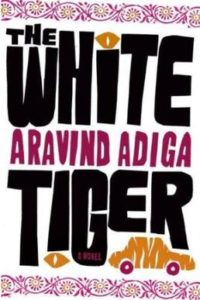 I found this novel to be endlessly entertaining, while at the same time very revealing and “educational” about many aspects of modern Indian culture. The piece is a story, in the form of letters to a Chinese leader, told by a self-made Indian man who rose from the lowly village life to become a successful businessman. This story in a sense is familiar one driving at classism – the haves and the have-nots and how the latter must serve the former – but the twist is the main character’s attitude towards it all. He’s matter of fact, rather accepting of the state of the system, and unemotional about his treatment or his callous means of rising up. It paints quite a stark and critical picture of the state of class in India. And I, as someone of Indian descent and having had a great deal of exposure to the culture, I find the stories, as well as the main character’s candid demeanor, completely unsurprising. The contradiction between these two things really makes the piece work – the obscene disparity in wealth with the straightforward description of the world – and creates for entertainment at a WTF level.
I found this novel to be endlessly entertaining, while at the same time very revealing and “educational” about many aspects of modern Indian culture. The piece is a story, in the form of letters to a Chinese leader, told by a self-made Indian man who rose from the lowly village life to become a successful businessman. This story in a sense is familiar one driving at classism – the haves and the have-nots and how the latter must serve the former – but the twist is the main character’s attitude towards it all. He’s matter of fact, rather accepting of the state of the system, and unemotional about his treatment or his callous means of rising up. It paints quite a stark and critical picture of the state of class in India. And I, as someone of Indian descent and having had a great deal of exposure to the culture, I find the stories, as well as the main character’s candid demeanor, completely unsurprising. The contradiction between these two things really makes the piece work – the obscene disparity in wealth with the straightforward description of the world – and creates for entertainment at a WTF level.
One thing to note about the audiobook version is that it is read by a white dude and he speaks in an Indian accent. Normally I’d be a bit weirded out by this as it often sounds like Apu, but the voice acting is surprisingly well suited for the character and does not appear demeaning whatsoever.
Girls & Sex: Navigating the Complicated New Landscape, by Peggy Orenstein
 I picked up this book after reading a terrific excerpt from the author’s then upcoming book, “Boys and Sex”. Simply put, this book explores the world that girls and young women find themselves in and it’s a challenging one, as revealed by the 70+ interviews conducted by the author. Most if not all find themselves held to a double standard – either you’re loose or you’re a prude. And it’s a world where boys and men generally hold power and get what they want while girls and young women are often left embarrassed or taken advantage of – starting as early as middle school and especially notable during college years with the frat party culture. The author does well to point out and challenge our many social constructs, which are rather arbitrary and unfair – like what constitutes sex or virginity. While the material is enlightening, there’s a a major caveat to consider: most of the girls and young women interviewed are white and from upper or middle class families (which the author does acknowledge), so there’s a lot of missing voices and only one culture is shown. I imagine different groups of people of color would show very different experiences. I also feel that the author gives an impression, in a bit of a sensationalized manner, that everyone is engaging in very sexual behavior, when there’s likely many people that are non-actors and essentially ignoring this sexual culture. That said, it’s worth noting that pretty much every girl or young woman faces the pressures noted in the book. Lastly, the book ends on an encouraging note: that it’s very possible to teach girls and especially boys – at a young age – that they can create a better and more fair culture that can bring everyone more joy.
I picked up this book after reading a terrific excerpt from the author’s then upcoming book, “Boys and Sex”. Simply put, this book explores the world that girls and young women find themselves in and it’s a challenging one, as revealed by the 70+ interviews conducted by the author. Most if not all find themselves held to a double standard – either you’re loose or you’re a prude. And it’s a world where boys and men generally hold power and get what they want while girls and young women are often left embarrassed or taken advantage of – starting as early as middle school and especially notable during college years with the frat party culture. The author does well to point out and challenge our many social constructs, which are rather arbitrary and unfair – like what constitutes sex or virginity. While the material is enlightening, there’s a a major caveat to consider: most of the girls and young women interviewed are white and from upper or middle class families (which the author does acknowledge), so there’s a lot of missing voices and only one culture is shown. I imagine different groups of people of color would show very different experiences. I also feel that the author gives an impression, in a bit of a sensationalized manner, that everyone is engaging in very sexual behavior, when there’s likely many people that are non-actors and essentially ignoring this sexual culture. That said, it’s worth noting that pretty much every girl or young woman faces the pressures noted in the book. Lastly, the book ends on an encouraging note: that it’s very possible to teach girls and especially boys – at a young age – that they can create a better and more fair culture that can bring everyone more joy.
Reset: My Fight for Inclusion and Lasting Change, by Ellen Pao
 If you’re a man reading about the trials (including a literal trial) and tribulations of an Asian American woman that simply wants her fair share for the exorbitant work she put into her career and for her employers, you will be left aghast by this author’s story. If you’re a woman with even a sliver of career experience, you’re likely to say “Yeah, what’s the big surprise here?” The author’s story told here is a familiar one to any woman with career ambition. She, an extremely accomplished and talented person, faces obstacles, roadblocks, harassment, false promises, and retaliation across a number of jobs in the tech field, with the story culminating with an unfortunate loss of a major lawsuit where she was simply outgunned. If you’re not pissed off reading the author’s words, then you’re part of a problem I’ve seen all too often in the tech world and beyond. While the author’s recounting feels as grim as it is revealing, she does lead us to some positive light between the culture changes she did manage to establish at one company, her own new organization to empower women, and the spark of movements generated by her story. There is one inconsistency in this piece, and that is that the author repeatedly points out that the tech company culture not only mistreats women, but also people of color – yet some of the bad actors she described happened to be male people of color. My explanation of this inconsistency, as a male person of color that works in tech, is that we too are screwed over, and those of us that absorb the bad culture tend to be the most visible when it comes to the negative behavior, while the white men at the top conduct their mistreatments in a very opaque and indirect manner. All that said, this book is powerful and well worth a read.
If you’re a man reading about the trials (including a literal trial) and tribulations of an Asian American woman that simply wants her fair share for the exorbitant work she put into her career and for her employers, you will be left aghast by this author’s story. If you’re a woman with even a sliver of career experience, you’re likely to say “Yeah, what’s the big surprise here?” The author’s story told here is a familiar one to any woman with career ambition. She, an extremely accomplished and talented person, faces obstacles, roadblocks, harassment, false promises, and retaliation across a number of jobs in the tech field, with the story culminating with an unfortunate loss of a major lawsuit where she was simply outgunned. If you’re not pissed off reading the author’s words, then you’re part of a problem I’ve seen all too often in the tech world and beyond. While the author’s recounting feels as grim as it is revealing, she does lead us to some positive light between the culture changes she did manage to establish at one company, her own new organization to empower women, and the spark of movements generated by her story. There is one inconsistency in this piece, and that is that the author repeatedly points out that the tech company culture not only mistreats women, but also people of color – yet some of the bad actors she described happened to be male people of color. My explanation of this inconsistency, as a male person of color that works in tech, is that we too are screwed over, and those of us that absorb the bad culture tend to be the most visible when it comes to the negative behavior, while the white men at the top conduct their mistreatments in a very opaque and indirect manner. All that said, this book is powerful and well worth a read.
Push, by Sapphire
 This novel, set in 1980s Harlem, is the story of a 17 year old black girl named Precious and told from her perspective. And given her circumstances, you’ll feel mightily privileged about your life in comparison. Precious grew up poor while being repeatedly raped by her father and disregarded by a mother who lives on welfare. The story starts with Precious pregnant by her father for the second time, recently kicked out of school, but about to embark on a journey that has the potential to transform her life. This piece is raw and the writing style makes no concessions in softening realities. And while this book is a work of fiction, what transpires could easily be pulled out of the history books we’d never read in our biased schooling. This piece is a short, quick, and easy read, and is the basis for the well received film “Precious”. The last few pages of the book contain a surprise that hits hard, making the piece seem like not one story but half a dozen. Definitely worth checking out.
This novel, set in 1980s Harlem, is the story of a 17 year old black girl named Precious and told from her perspective. And given her circumstances, you’ll feel mightily privileged about your life in comparison. Precious grew up poor while being repeatedly raped by her father and disregarded by a mother who lives on welfare. The story starts with Precious pregnant by her father for the second time, recently kicked out of school, but about to embark on a journey that has the potential to transform her life. This piece is raw and the writing style makes no concessions in softening realities. And while this book is a work of fiction, what transpires could easily be pulled out of the history books we’d never read in our biased schooling. This piece is a short, quick, and easy read, and is the basis for the well received film “Precious”. The last few pages of the book contain a surprise that hits hard, making the piece seem like not one story but half a dozen. Definitely worth checking out.
The Inheritance of Loss, by Kiran Desai (audiobook version)
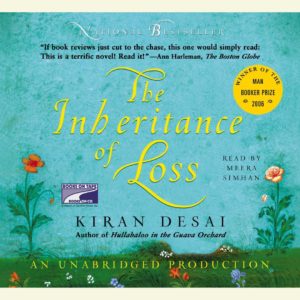 This novel is a grim one from start to finish. Set in Northeast India (bordering Nepal) and New York City in 1986 with a historical backdrop of political unrest, it follows the lives of a handful of interconnected characters primarily of Indian descent, ping ponging between them. The characters are complex – some anglicised, others politicized as illegal immigrants or freedom fighters – and they each grapple with a changed and changing world brought forth by colonialism. The internal battles include the modern vs the old, identity, and generations of loss. The book is fair game for everyone – South Asians will find commonality in the struggles while seeing deeper issues while everyone else will receive a great exposure to the plight and impact of colonialism. I highly recommend the audio book version as it’s read by an actress of South Asian descent who pronounces everything correctly (those that are Gujarati like myself will appreciate many specific words) and does a marvelous job acting out the different characters.
This novel is a grim one from start to finish. Set in Northeast India (bordering Nepal) and New York City in 1986 with a historical backdrop of political unrest, it follows the lives of a handful of interconnected characters primarily of Indian descent, ping ponging between them. The characters are complex – some anglicised, others politicized as illegal immigrants or freedom fighters – and they each grapple with a changed and changing world brought forth by colonialism. The internal battles include the modern vs the old, identity, and generations of loss. The book is fair game for everyone – South Asians will find commonality in the struggles while seeing deeper issues while everyone else will receive a great exposure to the plight and impact of colonialism. I highly recommend the audio book version as it’s read by an actress of South Asian descent who pronounces everything correctly (those that are Gujarati like myself will appreciate many specific words) and does a marvelous job acting out the different characters.
Tar Baby, by Toni Morrison
 I’d first read this novel in college for a class, and recently circled back to read more of the author’s work, as she’s masterful in her writing and especially so at conveying the perspective of black people. This piece centers around a number of characters including a black husband and wife couple, their niece, the white couple that they’ve worked for their entire lives, and a fugitive man. Morrison weaves in a number of themes involving obligation and betrayal between masters/servants, family/partners, and race/identity. Reading this story really popped this time around because in my naivety during college years, I’d considered much of the story very fictional and dramatized. But having since understood a greater depth of the history of race in America, I’ve come to realize that the events in this work of fiction undeniably could have played out as such in real life. The only qualm I feel with this work is that it felt like many of the important themes remained unexposed until too far into the story, but then again my ignorance may be keeping parts hidden still. Either way, the character portrayals are meticulous in their representations and that is more than plenty reason to check out novel. I look forward to reading more of Morrison’s work in the near future.
I’d first read this novel in college for a class, and recently circled back to read more of the author’s work, as she’s masterful in her writing and especially so at conveying the perspective of black people. This piece centers around a number of characters including a black husband and wife couple, their niece, the white couple that they’ve worked for their entire lives, and a fugitive man. Morrison weaves in a number of themes involving obligation and betrayal between masters/servants, family/partners, and race/identity. Reading this story really popped this time around because in my naivety during college years, I’d considered much of the story very fictional and dramatized. But having since understood a greater depth of the history of race in America, I’ve come to realize that the events in this work of fiction undeniably could have played out as such in real life. The only qualm I feel with this work is that it felt like many of the important themes remained unexposed until too far into the story, but then again my ignorance may be keeping parts hidden still. Either way, the character portrayals are meticulous in their representations and that is more than plenty reason to check out novel. I look forward to reading more of Morrison’s work in the near future.
On Earth We’re Briefly Gorgeous, by Ocean Vuong (audiobook version)
 This work cannot be considered anything less than a masterpiece. It is composed as the letter written by a son to his mother and reminiscent of the powerful “Between the World and Me” by Ta-Nehisi Coates, which was written as a letter from a father to his son. While this piece is technically fiction, it lines up closely with the Vuong’s own story – a gay, Vietnamese-American individual raised by his mother who’s a manicurist and his grandmother, with all settling in Hartford, Connecticut. Vuong is known for being a masterful poet, so it’s no surprise that this work feels like one magnificent poem from start to finish with an incredible use of words and especially metaphor. The story will wrench at you in all directions as Vuong conveys many lives – his mother’s exhausting day to day hardship, his grandmother’s plights – from early life, the Vietnam War, and death by cancer – his white male lover’s dealings with drug addiction, and of course the main character’s coming of age as an immigrant child growing up in America. I highly recommend the audiobook version, as it is evocatively read by Vuong himself.
This work cannot be considered anything less than a masterpiece. It is composed as the letter written by a son to his mother and reminiscent of the powerful “Between the World and Me” by Ta-Nehisi Coates, which was written as a letter from a father to his son. While this piece is technically fiction, it lines up closely with the Vuong’s own story – a gay, Vietnamese-American individual raised by his mother who’s a manicurist and his grandmother, with all settling in Hartford, Connecticut. Vuong is known for being a masterful poet, so it’s no surprise that this work feels like one magnificent poem from start to finish with an incredible use of words and especially metaphor. The story will wrench at you in all directions as Vuong conveys many lives – his mother’s exhausting day to day hardship, his grandmother’s plights – from early life, the Vietnam War, and death by cancer – his white male lover’s dealings with drug addiction, and of course the main character’s coming of age as an immigrant child growing up in America. I highly recommend the audiobook version, as it is evocatively read by Vuong himself.
Shanghai Girls, by Lisa See
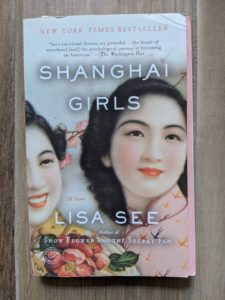 This novel centers on two sisters – told from the perspective of one of them – beginning in 1937 Shanghai. Their cosmopolitan life as young adults takes a turn as they’re arranged to be married off in order to repay their father’s gambling debts, and soon after war reaches shore. The story traces the trials and tribulations that follow: escaping certain doom, navigating an unjust American immigration system, and making a life as immigrants in a country that takes advantage of Chinese immigrants and thwarts their options for opportunity through discrimination and mistreatment through a multitude of ways. This is a work of historical fiction with a strong dose of historical backdrops including the Second Sino-Japanese War, internment practices at Angel Island, the Chinese Exclusion Act, and McCarthyism. Conversely, the story told could easily pass as a true one and is fact based on elements from interviews that the author, See, conducted on people that lived through these historical events. The narrative itself is very riveting and I could not put this book down. Several developed themes stood out to me: that men’s actions caused much harm to women, that immigrant families had complex dynamics due to strategies they needed to employ to survive in discriminatory America, and the constant fight for a better future. Highly recommended.
This novel centers on two sisters – told from the perspective of one of them – beginning in 1937 Shanghai. Their cosmopolitan life as young adults takes a turn as they’re arranged to be married off in order to repay their father’s gambling debts, and soon after war reaches shore. The story traces the trials and tribulations that follow: escaping certain doom, navigating an unjust American immigration system, and making a life as immigrants in a country that takes advantage of Chinese immigrants and thwarts their options for opportunity through discrimination and mistreatment through a multitude of ways. This is a work of historical fiction with a strong dose of historical backdrops including the Second Sino-Japanese War, internment practices at Angel Island, the Chinese Exclusion Act, and McCarthyism. Conversely, the story told could easily pass as a true one and is fact based on elements from interviews that the author, See, conducted on people that lived through these historical events. The narrative itself is very riveting and I could not put this book down. Several developed themes stood out to me: that men’s actions caused much harm to women, that immigrant families had complex dynamics due to strategies they needed to employ to survive in discriminatory America, and the constant fight for a better future. Highly recommended.
Dreams of Joy, by Lisa See
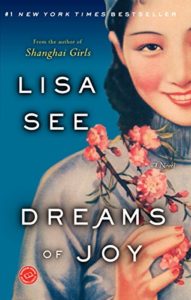 This novel is the sequel to my previous read, “Shanghai Girls”, which unexpectedly ended with a cliffhanger. It once again features two main characters, including the narrator of the previous book, Pearl, and this time her young adult daughter, Joy – with the narration alternating between the two of them. The story takes place in Mao’s China, situating itself alike between Shanghai and the village countryside. And while this historical fiction piece is bit more on the fiction side compared to its predecessor, there’s still plenty of historical backdrop. This includes the obstacles the characters must cleverly work around in a communist society (sending hidden messages across waters and getting across borders), the ironic social stratification that arose with this government structure (most people had little while leaders were very well off), and the dire consequences of the Mao’s ill-guided Great Leap Forward (mass death due to starvation). The author, See, does a wonderful job weaving this all together in a manner that includes a great deal of character development and I couldn’t help but keep reading to find out what happens next. There’s solid connections with the previous book as themes are artfully mirrored and mysterious loose ends surprisingly get tied up.
This novel is the sequel to my previous read, “Shanghai Girls”, which unexpectedly ended with a cliffhanger. It once again features two main characters, including the narrator of the previous book, Pearl, and this time her young adult daughter, Joy – with the narration alternating between the two of them. The story takes place in Mao’s China, situating itself alike between Shanghai and the village countryside. And while this historical fiction piece is bit more on the fiction side compared to its predecessor, there’s still plenty of historical backdrop. This includes the obstacles the characters must cleverly work around in a communist society (sending hidden messages across waters and getting across borders), the ironic social stratification that arose with this government structure (most people had little while leaders were very well off), and the dire consequences of the Mao’s ill-guided Great Leap Forward (mass death due to starvation). The author, See, does a wonderful job weaving this all together in a manner that includes a great deal of character development and I couldn’t help but keep reading to find out what happens next. There’s solid connections with the previous book as themes are artfully mirrored and mysterious loose ends surprisingly get tied up.
Exhalation: Stories, by Ted Chiang (audiobook version)
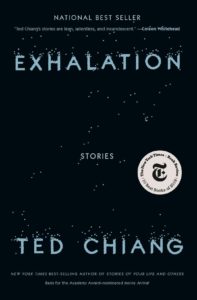 This work is a collection of science fiction stories ranging from very short – mere minutes – to lengthy – a few hours – with an appeal that’s broader than what’s typical for the sci-fi genre. In each story the author, Chiang, blends a concept of science or technology with culture, ethics, religion, faith, and/or fate, and leaves you truly thinking about the consequences in that world and how they relate to our own. The first story explores time travel in a universe where everything is predetermined with a surprisingly well-suited backdrop of Islamic faith. Another story explores the ethics of raising digital lifeforms. Yet another correlates the principle of entropy to an ever losing battle to sustain what gives us life. Another looks at how science’s great purpose is to reveal the work of an almighty creator. The final story explores the ability to communicate across multiverses and one’s alternative selves. There’s plenty more stories in between and oftentimes leave me wanting more. They’re just all so damn good. Following most of the stories, we also get a little brief from the author on the inspiration behind them. I found the audiobook version very enjoyable as the stories are read by what appear to be professional voice actors. And if you do choose to listen to it, I recommend doing so alongside a loved one or friend, as you’ll certainly want someone to talk to about what transpires.
This work is a collection of science fiction stories ranging from very short – mere minutes – to lengthy – a few hours – with an appeal that’s broader than what’s typical for the sci-fi genre. In each story the author, Chiang, blends a concept of science or technology with culture, ethics, religion, faith, and/or fate, and leaves you truly thinking about the consequences in that world and how they relate to our own. The first story explores time travel in a universe where everything is predetermined with a surprisingly well-suited backdrop of Islamic faith. Another story explores the ethics of raising digital lifeforms. Yet another correlates the principle of entropy to an ever losing battle to sustain what gives us life. Another looks at how science’s great purpose is to reveal the work of an almighty creator. The final story explores the ability to communicate across multiverses and one’s alternative selves. There’s plenty more stories in between and oftentimes leave me wanting more. They’re just all so damn good. Following most of the stories, we also get a little brief from the author on the inspiration behind them. I found the audiobook version very enjoyable as the stories are read by what appear to be professional voice actors. And if you do choose to listen to it, I recommend doing so alongside a loved one or friend, as you’ll certainly want someone to talk to about what transpires.
How To Be Less Stupid About Race, by Crystal M. Fleming, PhD
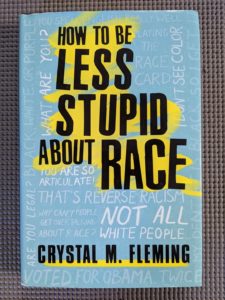 As you might guess from the title, this book holds back no punches. And the author has the power to back them given that she’s earned degrees at Wellesley and Harvard, and is currently a professor at my alma mater, Stony Brook University. Ironically though, the author, Fleming, points out that this “liberal” education did little to teach her about race, and is instead part of the greater problem. So with that in mind, it might come as a surprise to you that those of a liberal bent are an especially appropriate audience for this work, more so I’d say than the often called racist conservatives. This book starts especially strong, laying out all sorts of fallacies – used by those across the entire political spectrum – right from the get go. Fleming then focuses on a particular issue of race in each chapter. One chapter discusses how black women have had and continue to have their voice put down by everyone else, especially white and non-black POC women. Another is particularly revealing on how Obama served as a perfect token to carry out the structural racism behind the scenes while giving its beneficiaries, especially liberal elites, something to feel good about. Yet another strong chapter discusses how the media contributes in its own ways to structural racism, with particular callouts against The New York Times. Another chapter delves into one’s racism while being partnered with someone from a marginalized race. I connected strongly with the author’s background as much like myself, she had enough privilege and opportunities to rise through the system while being shielded from much of the structural racism, only becoming educated about it in more recent years. And I did indeed learn a lot from this work along with having plenty of my suspicions confirmed. For example, the whole notion of political correctness hinges on the fact that America has been openly racist for most of its history and that the civil rights movement of the 1960s made it no longer okay to do so, at least publicly, pushing racism behind closed doors to this day. As I noted above, I highly recommend this read to those who claim to be liberal and anti-racist, as it’ll reveal to you how you’re just being played into pushing forth the system that you think or claim to be fighting against.
As you might guess from the title, this book holds back no punches. And the author has the power to back them given that she’s earned degrees at Wellesley and Harvard, and is currently a professor at my alma mater, Stony Brook University. Ironically though, the author, Fleming, points out that this “liberal” education did little to teach her about race, and is instead part of the greater problem. So with that in mind, it might come as a surprise to you that those of a liberal bent are an especially appropriate audience for this work, more so I’d say than the often called racist conservatives. This book starts especially strong, laying out all sorts of fallacies – used by those across the entire political spectrum – right from the get go. Fleming then focuses on a particular issue of race in each chapter. One chapter discusses how black women have had and continue to have their voice put down by everyone else, especially white and non-black POC women. Another is particularly revealing on how Obama served as a perfect token to carry out the structural racism behind the scenes while giving its beneficiaries, especially liberal elites, something to feel good about. Yet another strong chapter discusses how the media contributes in its own ways to structural racism, with particular callouts against The New York Times. Another chapter delves into one’s racism while being partnered with someone from a marginalized race. I connected strongly with the author’s background as much like myself, she had enough privilege and opportunities to rise through the system while being shielded from much of the structural racism, only becoming educated about it in more recent years. And I did indeed learn a lot from this work along with having plenty of my suspicions confirmed. For example, the whole notion of political correctness hinges on the fact that America has been openly racist for most of its history and that the civil rights movement of the 1960s made it no longer okay to do so, at least publicly, pushing racism behind closed doors to this day. As I noted above, I highly recommend this read to those who claim to be liberal and anti-racist, as it’ll reveal to you how you’re just being played into pushing forth the system that you think or claim to be fighting against.
Song of Solomon, by Toni Morrison
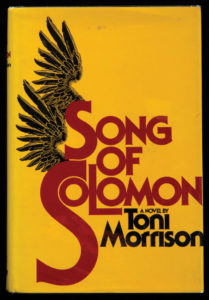 A classic from the incredible Toni Morrison, this novel follows the arc, growth, and coming of age of a boy as he transforms into a man. Themes of identity, personal freedom, and family history play significant roles in this piece. And of course notions of race and blackness are interwoven throughout the piece in subtle ways – with Morrison just immersing the reader in aspects of black culture without explaining it – as well as more obvious ways. With regard to the latter, issues of race like those involving legal inequality and police brutality come up, which is especially relevant today, despite that fact that this work was published over 40 years ago. Morrison’s writing is astonishingly poetic and it often feels like reading a dream. There’s plenty more to appreciate about this piece. It’s engaging and I couldn’t put it down, once I got past the beginning which was left mysterious and a bit difficult to follow for me. And while the main character is a man, I really appreciate that plenty of other characters are women, and especially strong ones at that.
A classic from the incredible Toni Morrison, this novel follows the arc, growth, and coming of age of a boy as he transforms into a man. Themes of identity, personal freedom, and family history play significant roles in this piece. And of course notions of race and blackness are interwoven throughout the piece in subtle ways – with Morrison just immersing the reader in aspects of black culture without explaining it – as well as more obvious ways. With regard to the latter, issues of race like those involving legal inequality and police brutality come up, which is especially relevant today, despite that fact that this work was published over 40 years ago. Morrison’s writing is astonishingly poetic and it often feels like reading a dream. There’s plenty more to appreciate about this piece. It’s engaging and I couldn’t put it down, once I got past the beginning which was left mysterious and a bit difficult to follow for me. And while the main character is a man, I really appreciate that plenty of other characters are women, and especially strong ones at that.
Resistance: A Songwriter’s Story of Hope, Change, and Courage, by Tori Amos (audiobook edition)
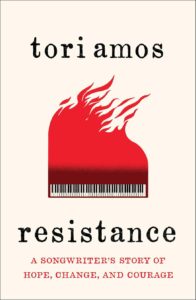 Known for her songs that hit a wide range of politically relevant subjects, the singer-songwriter pianist, Tori Amos, expands with a work that tells a deeper story that encompasses her own life. Each chapter begins with one of her songs, and she dives into a greater meaning beneath the song as there’s personal and/or political matters at hand. Amos begins with her time as a teenager playing piano at hotel bars in Washington DC frequented by the politically elite. She talks about the quid pro quo patriarchal power structures within the music industry, offering seamless comparisons with similar structures in our government. This work is emotionally evocative on a personal and society level, and well worth a check out. I recommend the audiobook version if that’s your thing as it’s read by Amos herself. Her emotions and presence of energy inhabit every chapter, from the reading of lyrics to throughout the stories that follow.
Known for her songs that hit a wide range of politically relevant subjects, the singer-songwriter pianist, Tori Amos, expands with a work that tells a deeper story that encompasses her own life. Each chapter begins with one of her songs, and she dives into a greater meaning beneath the song as there’s personal and/or political matters at hand. Amos begins with her time as a teenager playing piano at hotel bars in Washington DC frequented by the politically elite. She talks about the quid pro quo patriarchal power structures within the music industry, offering seamless comparisons with similar structures in our government. This work is emotionally evocative on a personal and society level, and well worth a check out. I recommend the audiobook version if that’s your thing as it’s read by Amos herself. Her emotions and presence of energy inhabit every chapter, from the reading of lyrics to throughout the stories that follow.
Gun Island, by Amitav Ghosh
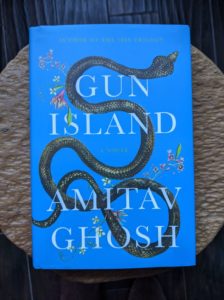 This novel is a rather timely one, released just last year. Taking place in current times, It features a middle aged Bengali Indian man, Deen, accustomed to his calm life of selling rare books in Brooklyn, embarking on an adventure to solve an old mystery with chilling parallels of present circumstances. As Deen travels between Brooklyn, his home land of Bengal, and Venice, he runs into a slew of interesting characters including an old Italian friend, a fellow Begali American who’s an woman environmental scientist, and an entrepreneurial boy who’s caught up in the human migration “business”. Speaking of migration, it’s a central theme for people and animals alike, due to changing climatic conditions. As Deen breaks down the mystery, we see other relevant themes pop up – the disconnect between man and nature, the greed that harms us humans, the notion of culture in a land served by immigrants, and the politics of refugees. There’s even a reference to a pandemic! This piece is a wonderful, enjoyable read! And it’s fabulous to see a modern day piece where the protagonist is South Asian, with other major characters represented by strong women.
This novel is a rather timely one, released just last year. Taking place in current times, It features a middle aged Bengali Indian man, Deen, accustomed to his calm life of selling rare books in Brooklyn, embarking on an adventure to solve an old mystery with chilling parallels of present circumstances. As Deen travels between Brooklyn, his home land of Bengal, and Venice, he runs into a slew of interesting characters including an old Italian friend, a fellow Begali American who’s an woman environmental scientist, and an entrepreneurial boy who’s caught up in the human migration “business”. Speaking of migration, it’s a central theme for people and animals alike, due to changing climatic conditions. As Deen breaks down the mystery, we see other relevant themes pop up – the disconnect between man and nature, the greed that harms us humans, the notion of culture in a land served by immigrants, and the politics of refugees. There’s even a reference to a pandemic! This piece is a wonderful, enjoyable read! And it’s fabulous to see a modern day piece where the protagonist is South Asian, with other major characters represented by strong women.
Parable of the Sower, by Octavia E. Butler
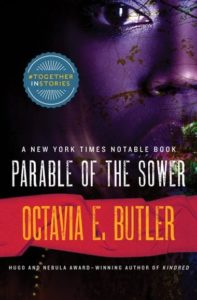 This dystopian future novel is as frightening as it is engaging, which is to say big time on both fronts. It follows a black teenage / young adult woman through her pursuit of survival in a time where society has long broken down. It’s a particularly bleak picture in Southern California, along with the rest of the country, where the economy has collapsed and humans must form small self subsisting enclaves to survive – if they’re lucky – and resort to violent and animalistic behavior if not so lucky. And the story only gets more bleak: however bad the situation is for our protagonist, it only becomes worse as time goes on. And for an extra bit of discomfort, this “future” takes place in the mid 2020s, not far from now, though the piece was written in 1993. There’s lots of interesting themes at play here: That most of the population is poor and barely able to make do, if at all – usually at the expense of others. That the rich are able form their own walled gardens. That the government is full of false hope and empty promises. That corporations have enough power to create their own walled cities with essentially indentured servants as employees. The roles of family power dynamics. The grounding and ungrounding presence of religion. The matter of race and trust in other human beings. Perhaps most unreal is how our society might very well see this as a reality as we’ve slowly been slipping to a place of economic disparity and turbulence. As I mentioned, this is a gripping read, and it is structured as journal entries written in first person by our protagonist. Check it out!
This dystopian future novel is as frightening as it is engaging, which is to say big time on both fronts. It follows a black teenage / young adult woman through her pursuit of survival in a time where society has long broken down. It’s a particularly bleak picture in Southern California, along with the rest of the country, where the economy has collapsed and humans must form small self subsisting enclaves to survive – if they’re lucky – and resort to violent and animalistic behavior if not so lucky. And the story only gets more bleak: however bad the situation is for our protagonist, it only becomes worse as time goes on. And for an extra bit of discomfort, this “future” takes place in the mid 2020s, not far from now, though the piece was written in 1993. There’s lots of interesting themes at play here: That most of the population is poor and barely able to make do, if at all – usually at the expense of others. That the rich are able form their own walled gardens. That the government is full of false hope and empty promises. That corporations have enough power to create their own walled cities with essentially indentured servants as employees. The roles of family power dynamics. The grounding and ungrounding presence of religion. The matter of race and trust in other human beings. Perhaps most unreal is how our society might very well see this as a reality as we’ve slowly been slipping to a place of economic disparity and turbulence. As I mentioned, this is a gripping read, and it is structured as journal entries written in first person by our protagonist. Check it out!
Parable of the Talents, by Octavia E. Butler
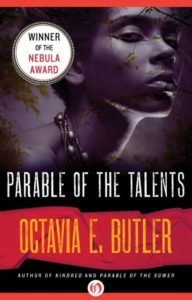 This is the sequel to the my previous read, “Parable of the Sower”, picking off shortly beyond where its predecessor left off. And while I found the first book to be scary, this next one is downright chilling. Why? Because this 1998 piece quite accurately predicts the rise of Christian fanaticism during the 2020s, complete with a leader who pushes his followers to bring violence on others (while simultaneously claiming to “condemn” such acts and say he supports diversity), who manages to become president of the US, and rides a political line to “Make America Great Again”. We find our protagonist, a black woman, alongside her newly formed tribe in contact with such fanatics – whose greater organization “Christian America” claims to be doing good while simultaneously abusing their power to a great extreme, not unlike what the less savory parts of our human history is rife with. And with this being set in the future, there’s technologies available to enslave individuals in utterly insidious ways. Needless to say, this novel is another gripping one and perhaps painful to read at parts (in a good way). This book is structured similarly to the first, with everything in the form of journal entries. But instead of the entries being from just the protagonist, there’s extensive entries of her daughter and a few by other characters. This piece might be fiction, but much of it could be a reality soon given the state of our country.
This is the sequel to the my previous read, “Parable of the Sower”, picking off shortly beyond where its predecessor left off. And while I found the first book to be scary, this next one is downright chilling. Why? Because this 1998 piece quite accurately predicts the rise of Christian fanaticism during the 2020s, complete with a leader who pushes his followers to bring violence on others (while simultaneously claiming to “condemn” such acts and say he supports diversity), who manages to become president of the US, and rides a political line to “Make America Great Again”. We find our protagonist, a black woman, alongside her newly formed tribe in contact with such fanatics – whose greater organization “Christian America” claims to be doing good while simultaneously abusing their power to a great extreme, not unlike what the less savory parts of our human history is rife with. And with this being set in the future, there’s technologies available to enslave individuals in utterly insidious ways. Needless to say, this novel is another gripping one and perhaps painful to read at parts (in a good way). This book is structured similarly to the first, with everything in the form of journal entries. But instead of the entries being from just the protagonist, there’s extensive entries of her daughter and a few by other characters. This piece might be fiction, but much of it could be a reality soon given the state of our country.
Rest: How to Get More Done When You Work Less, by Alex Soojung-Kim Pang
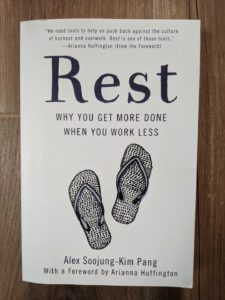 I was under the impression that this book would be about “rest” as in the form of relaxation and vacations and such, especially given the flip flops on the cover. But it turns out to be yet another hyper-productivity book, this time using anything “non-work” as the definition of rest. And I shouldn’t have been surprised given that the author, Pang, is based in Silicon Valley, the land of over-optimization. That said, this book ultimately did prove interesting and useful to me. The central premise is that we ought to work smarter, not harder, and a core aspect of working smarter is to get away from work – with chapters dedicated to particular ways of not-working. Many of the chapters hit areas that aren’t well accepted, but confirmed what I already suspected or understood based on my own experience. Like that about four hours is the upper bound of the amount of creative work that can be done in a day, at least for a particular domain. And that naps can play a vital role in supercharging one’s thinking and productivity – and while the author included some science to support this, I wish he went into further detail, like explaining that it’s possible to get into REM cycle during a 20 minute power nap (my personal speciality). Conversely, the author discussed methods of improving creative work that surprised me. That one should not wait to be inspired or feel creative before they start working, but instead need to start working and do so consistently, regardless of mood, and that eventually the mood will take hold on its own. Also, the author noted that most creative work does in fact get done in earlier part of the day – even for night owls. So with these two concepts in mind, I’d switched around my schedule the past weeks, forcing myself to sit down for my contract software work at the beginning of the day, and I can say that it’s worked marvelously. Unfortunately, much like our own creative energy, this book does lose steam in the latter parts, where it feels the author is captain obvious. He delves into chapters concerning sleep, exercise, “deep play” (which seemed like a rehash of previous chapters), and sabbaticals. They seemed like no brainers to me, but then again, perhaps not everyone is convinced of all this interplay and it’s nice to have a reminder. If you’re finding yourself with more unstructured time these days and find the days slipping by and yourself feeling guilty about it (I’ll raise my hand to that), this book is definitely worth checking out.
I was under the impression that this book would be about “rest” as in the form of relaxation and vacations and such, especially given the flip flops on the cover. But it turns out to be yet another hyper-productivity book, this time using anything “non-work” as the definition of rest. And I shouldn’t have been surprised given that the author, Pang, is based in Silicon Valley, the land of over-optimization. That said, this book ultimately did prove interesting and useful to me. The central premise is that we ought to work smarter, not harder, and a core aspect of working smarter is to get away from work – with chapters dedicated to particular ways of not-working. Many of the chapters hit areas that aren’t well accepted, but confirmed what I already suspected or understood based on my own experience. Like that about four hours is the upper bound of the amount of creative work that can be done in a day, at least for a particular domain. And that naps can play a vital role in supercharging one’s thinking and productivity – and while the author included some science to support this, I wish he went into further detail, like explaining that it’s possible to get into REM cycle during a 20 minute power nap (my personal speciality). Conversely, the author discussed methods of improving creative work that surprised me. That one should not wait to be inspired or feel creative before they start working, but instead need to start working and do so consistently, regardless of mood, and that eventually the mood will take hold on its own. Also, the author noted that most creative work does in fact get done in earlier part of the day – even for night owls. So with these two concepts in mind, I’d switched around my schedule the past weeks, forcing myself to sit down for my contract software work at the beginning of the day, and I can say that it’s worked marvelously. Unfortunately, much like our own creative energy, this book does lose steam in the latter parts, where it feels the author is captain obvious. He delves into chapters concerning sleep, exercise, “deep play” (which seemed like a rehash of previous chapters), and sabbaticals. They seemed like no brainers to me, but then again, perhaps not everyone is convinced of all this interplay and it’s nice to have a reminder. If you’re finding yourself with more unstructured time these days and find the days slipping by and yourself feeling guilty about it (I’ll raise my hand to that), this book is definitely worth checking out.
A World Between, by Emily Hashimoto
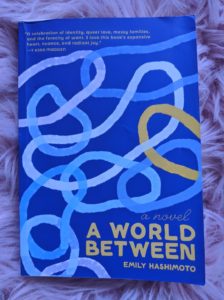 This novel is particularly special for a couple of reasons. First, one of the main characters is a Gujarati Indian American, like myself. And second, the author is one my colleagues at my main work client, Idealist. The story centers on two American women, Eleanor Suzuki, of Japanese and Jewish descent, and Leena Shah, of Indian descent. The two first meet in college and experience an intense yet brisk period of romance that’s abruptly cut short, and they meet again years later by chance as more “established” adults, rejuvenating their connection. The story hits in so many ways – the frustrating millennial quest to do socially meaningful work; living in a lesbian culture with antagonistic forces of the freedom offered by exposure to feminism and the single-path mentality of traditional immigrant families; what makes for friendship and romance and love; and insecurity and communication. The story is well written with colorful characterizations of locations (including Boston, SF, and NYC) and of emotions. While written in third person, it alternates focus between Eleanor and Leena’s perspectives, respectively, between different segments of the book. I found this to be pretty cool because we always had direct access to the feelings, often insecurity, of the character at hand, while the other character came off as more a mystery – and yet seeing this happen on both sides indicated how similar they were. I especially appreciate that the author, Hashimoto, was accurate in her portrayal of Gujarati Indian American life including the “single-path mentality” coming from immigrants parents and the pressure for American raised kids to navigate a very different world. Lastly, this book is a testament to the complex world that women, especially of color, must navigate, and it even goes up a level with the author herself, who wrote the piece somewhere in between her full time job and caring for a newborn.
This novel is particularly special for a couple of reasons. First, one of the main characters is a Gujarati Indian American, like myself. And second, the author is one my colleagues at my main work client, Idealist. The story centers on two American women, Eleanor Suzuki, of Japanese and Jewish descent, and Leena Shah, of Indian descent. The two first meet in college and experience an intense yet brisk period of romance that’s abruptly cut short, and they meet again years later by chance as more “established” adults, rejuvenating their connection. The story hits in so many ways – the frustrating millennial quest to do socially meaningful work; living in a lesbian culture with antagonistic forces of the freedom offered by exposure to feminism and the single-path mentality of traditional immigrant families; what makes for friendship and romance and love; and insecurity and communication. The story is well written with colorful characterizations of locations (including Boston, SF, and NYC) and of emotions. While written in third person, it alternates focus between Eleanor and Leena’s perspectives, respectively, between different segments of the book. I found this to be pretty cool because we always had direct access to the feelings, often insecurity, of the character at hand, while the other character came off as more a mystery – and yet seeing this happen on both sides indicated how similar they were. I especially appreciate that the author, Hashimoto, was accurate in her portrayal of Gujarati Indian American life including the “single-path mentality” coming from immigrants parents and the pressure for American raised kids to navigate a very different world. Lastly, this book is a testament to the complex world that women, especially of color, must navigate, and it even goes up a level with the author herself, who wrote the piece somewhere in between her full time job and caring for a newborn.
Men Without Women, by Haruki Murakami
 Written by perhaps Japan’s most famous novelist, and one that’s renowned across the world, this work is a collection of short stories each circling about a theme of some man as he’s affected by some sort of relationship with a woman of significance in his life. One story explores a man’s attempt to understand why his deceased wife had affairs. Another story looks at a young man’s resistance to fulfill a seemingly perfect relationship. Yet another story is a remix of Kafka’s “Metamorphosis”. The stories are easy to read and follow and are incredibly engaging. Conversely, I found a few things that were not to my taste. First is that many of the stories seemed to end abruptly, as if there was a huge build up, only to end by leaving things mysterious. Second is that many of the men seem, for lack of a better word, pathetic; and this seems to be the theme of many of Murakami’s work. That said, I found the secondary characters to the story to be very interesting and noteworthy, especially when they were women.
Written by perhaps Japan’s most famous novelist, and one that’s renowned across the world, this work is a collection of short stories each circling about a theme of some man as he’s affected by some sort of relationship with a woman of significance in his life. One story explores a man’s attempt to understand why his deceased wife had affairs. Another story looks at a young man’s resistance to fulfill a seemingly perfect relationship. Yet another story is a remix of Kafka’s “Metamorphosis”. The stories are easy to read and follow and are incredibly engaging. Conversely, I found a few things that were not to my taste. First is that many of the stories seemed to end abruptly, as if there was a huge build up, only to end by leaving things mysterious. Second is that many of the men seem, for lack of a better word, pathetic; and this seems to be the theme of many of Murakami’s work. That said, I found the secondary characters to the story to be very interesting and noteworthy, especially when they were women.
Stories of Your Life and Others, by Ted Chiang (audiobook version)
 After enjoying Chiang’s most recent collection of short stories, Exhalation, I was craving more. This set of short stories, like Exhalation, follows themes of science fiction, religion, alternative and futuristic technologies, and a deep look at societal and ethical implications of the situation at hand. One story is an alternative version of the Towel of Babel story. Another covers the psychological breakdown of a mathematician whose proof undermines all of math and determines her world to be a lie. Yet another looks at the concept of heaven, hell, and what it means to love god unconditionally in a suspenseful, action-packed tale that includes powerful angels. Yet another was the basis for the movie, “Arrival” (the short story version is much better). And a story that really left a mark was one that looked into the ethical tradeoffs of a world where others can’t be judged by attractiveness. The stories are engaging and timeless (especially as they were published in 2002), and if you choose the audiobook version, the readings are very well done.
After enjoying Chiang’s most recent collection of short stories, Exhalation, I was craving more. This set of short stories, like Exhalation, follows themes of science fiction, religion, alternative and futuristic technologies, and a deep look at societal and ethical implications of the situation at hand. One story is an alternative version of the Towel of Babel story. Another covers the psychological breakdown of a mathematician whose proof undermines all of math and determines her world to be a lie. Yet another looks at the concept of heaven, hell, and what it means to love god unconditionally in a suspenseful, action-packed tale that includes powerful angels. Yet another was the basis for the movie, “Arrival” (the short story version is much better). And a story that really left a mark was one that looked into the ethical tradeoffs of a world where others can’t be judged by attractiveness. The stories are engaging and timeless (especially as they were published in 2002), and if you choose the audiobook version, the readings are very well done.
Hit Refresh: The Quest to Rediscover Microsoft’s Soul and Imagine a Better Future for Everyone, by Satya Nadella
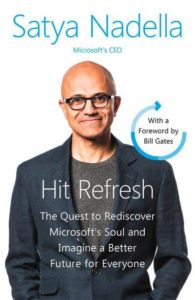 I was recently commenting on the double whammy fact about positions of power being less accessible to people of color AND how our media hardly gives attention to the POC that still manage to come to positions of power. A case in point being Satya Nadella, an Indian immigrant that not only rose to become the CEO of Microsoft a few years ago, but incredibly turned around what was surely a sunk ship into perhaps the most grounded tech company around today. So upon discovering he’d published a book a couple years ago, I had to read it. Now first things first: a lot of the sort of books written by CEOs tend to be the same with the author talking about some lucky/privilege upbringing, bringing in some personal life analogies that fit crudely at best, changing company structure/culture, and doing a ton of name dropping/thanking of people at the company. This book, unsurprisingly, has all of those things. But a few things did stand out. First is that Nadella was actually part of a special school in India which wasn’t highly regarded but somehow churned out a ton of future CEOs. Second is that he managed to circumvent racial barriers to some degree simply because he had grown up in the majority and with privilege (in India) and was simply able to confidently shrug off discrimination as ignorance. Third is that he faces a great challenge with a son with cerebral palsy, and this in turn shaped his vision for Microsoft being a technological force to create accessibility for all people. Combined with Nadella’s story of his path, they’re worthwhile sections of the book so that’s plenty of reason to check it out, especially if you’re in the tech world.
I was recently commenting on the double whammy fact about positions of power being less accessible to people of color AND how our media hardly gives attention to the POC that still manage to come to positions of power. A case in point being Satya Nadella, an Indian immigrant that not only rose to become the CEO of Microsoft a few years ago, but incredibly turned around what was surely a sunk ship into perhaps the most grounded tech company around today. So upon discovering he’d published a book a couple years ago, I had to read it. Now first things first: a lot of the sort of books written by CEOs tend to be the same with the author talking about some lucky/privilege upbringing, bringing in some personal life analogies that fit crudely at best, changing company structure/culture, and doing a ton of name dropping/thanking of people at the company. This book, unsurprisingly, has all of those things. But a few things did stand out. First is that Nadella was actually part of a special school in India which wasn’t highly regarded but somehow churned out a ton of future CEOs. Second is that he managed to circumvent racial barriers to some degree simply because he had grown up in the majority and with privilege (in India) and was simply able to confidently shrug off discrimination as ignorance. Third is that he faces a great challenge with a son with cerebral palsy, and this in turn shaped his vision for Microsoft being a technological force to create accessibility for all people. Combined with Nadella’s story of his path, they’re worthwhile sections of the book so that’s plenty of reason to check it out, especially if you’re in the tech world.
How to Be an Antiracist, by Ibram X. Kendi
 This book has appropriately been making its rounds over the past year and I finally made the opportunity to check it out. And I’m gonna say this right up front: if you consider yourself to be a non-racist person (and I assume all ya’ll do), then go read this book, because it is so clear with its definitions and explanations, and will totally help you answer your own questions while sussing out your own biases. The author, Kendi, starts by noting that there’s no neutral ground when it comes racism – that we are either behaving in ways that are ACTIVELY against racism, and if we’re not doing that then we are harboring some form of racism, even and especially if we choose to be passive about the manner. Kendi goes on to turn a few other things around: that what makes for our inequitable world can be divided into racist policy and racist ideas, and that racist policy actually creates racist ideas, and not the other way as around as many of us believe. He also points out that much of our policy (and the racist ideas that follow) – which are created by individual people – come more from self-interested profit than anything else, and I found his correlation of the origin of modern day capitalism with the transatlantic slave trade with it especially interesting. The arrangement of this book is absolutely terrific as tells a good story, and more importantly is well organized in practical manner to break down all the dimensions of the world of racism (and anti-racism). The book follows the author’s own journey, from childhood to present day, of experiencing racism in not just his American life, but within himself, capping off his progression to becoming antiracist. It’s thoughtfully structured as each chapter explores a part of his life, lasering in on a particular lens of racism. Some of these areas of focus include: biology, ethnicity, culture, behavior, class, gender, sexuality, to name a few. So the engineer in me really appreciated this structuring. Meanwhile, the human in me really enjoyed Kendi’s story as he spoke about growing up in Queens, NY (my hometown), his own transformation from non-studious to academic, and from unconsciously racist to actively antiracist.
This book has appropriately been making its rounds over the past year and I finally made the opportunity to check it out. And I’m gonna say this right up front: if you consider yourself to be a non-racist person (and I assume all ya’ll do), then go read this book, because it is so clear with its definitions and explanations, and will totally help you answer your own questions while sussing out your own biases. The author, Kendi, starts by noting that there’s no neutral ground when it comes racism – that we are either behaving in ways that are ACTIVELY against racism, and if we’re not doing that then we are harboring some form of racism, even and especially if we choose to be passive about the manner. Kendi goes on to turn a few other things around: that what makes for our inequitable world can be divided into racist policy and racist ideas, and that racist policy actually creates racist ideas, and not the other way as around as many of us believe. He also points out that much of our policy (and the racist ideas that follow) – which are created by individual people – come more from self-interested profit than anything else, and I found his correlation of the origin of modern day capitalism with the transatlantic slave trade with it especially interesting. The arrangement of this book is absolutely terrific as tells a good story, and more importantly is well organized in practical manner to break down all the dimensions of the world of racism (and anti-racism). The book follows the author’s own journey, from childhood to present day, of experiencing racism in not just his American life, but within himself, capping off his progression to becoming antiracist. It’s thoughtfully structured as each chapter explores a part of his life, lasering in on a particular lens of racism. Some of these areas of focus include: biology, ethnicity, culture, behavior, class, gender, sexuality, to name a few. So the engineer in me really appreciated this structuring. Meanwhile, the human in me really enjoyed Kendi’s story as he spoke about growing up in Queens, NY (my hometown), his own transformation from non-studious to academic, and from unconsciously racist to actively antiracist.
No One Can Pronounce My Name, by Rakesh Satyal
 This novel might just be my favorite read of the year, and I had the pleasure of hanging with the author when I was a guest at an artist’s retreat in Italy last year. The story, taking place in Cleveland, centers on two middle aged individuals that immigrated from India decades earlier: Harit works in a menswear store, lives with his mother, and is in the midst of dealing with a second family tragedy, while Ranjana is a married woman who’s just seen off her son to college and looking to break out of her predictable married life by secretly bringing herself to a writer’s club. This book is about many things including friendship, love, navigating an American world as Indians (whether raised abroad or born here), being gay, individual histories/tragedies, and developing one’s self by developing relationships with others. And these others include an assortment of well developed characters which include Harit and Ranjana’s respective coworkers and family members. The whole story really comes together, as the author, Satyal, does a masterful job diving into tenuous themes while keeping the work wholesome throughout. Well worth a read!
This novel might just be my favorite read of the year, and I had the pleasure of hanging with the author when I was a guest at an artist’s retreat in Italy last year. The story, taking place in Cleveland, centers on two middle aged individuals that immigrated from India decades earlier: Harit works in a menswear store, lives with his mother, and is in the midst of dealing with a second family tragedy, while Ranjana is a married woman who’s just seen off her son to college and looking to break out of her predictable married life by secretly bringing herself to a writer’s club. This book is about many things including friendship, love, navigating an American world as Indians (whether raised abroad or born here), being gay, individual histories/tragedies, and developing one’s self by developing relationships with others. And these others include an assortment of well developed characters which include Harit and Ranjana’s respective coworkers and family members. The whole story really comes together, as the author, Satyal, does a masterful job diving into tenuous themes while keeping the work wholesome throughout. Well worth a read!
Internment, by Samira Ahmed
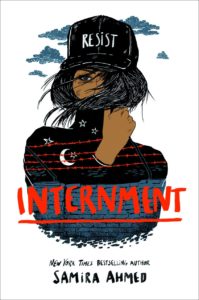 This novel, published in 2019, is set “15 minutes into the future” where the US administration has instituted an internal Muslim ban. The main character, a 17 year old American, Layla Amin, along with her parents, face sudden and increasingly restricted lives from the loss of access to school and work to curfews. Ultimately they are forcefully shuttled to an internment camp alongside hundreds of other Americans of Muslim faith. And while “settling” into this new prisoner, I mean, internee life, Layla must find a way out for herself and her family, seeking some means of help from the outside (like her Jewish boyfriend and social media) and from others inside the camp. This book takes cues from the years long internment of American citizens of Japanese descent during World War II and given this recent history along with the administration we’ve had in America the past four years, this book would have been downright frightening to read. That said, it was incredibly engaging and I finished it in a matter of days. It’s also a very easy and straightforward read so it’s a great pick for teenagers, especially given that the main character is one. And while I found this novel to be overdramatic to a theatrical level – they could probably turn this into a great movie without having to change a thing – it’s well worth a read!
This novel, published in 2019, is set “15 minutes into the future” where the US administration has instituted an internal Muslim ban. The main character, a 17 year old American, Layla Amin, along with her parents, face sudden and increasingly restricted lives from the loss of access to school and work to curfews. Ultimately they are forcefully shuttled to an internment camp alongside hundreds of other Americans of Muslim faith. And while “settling” into this new prisoner, I mean, internee life, Layla must find a way out for herself and her family, seeking some means of help from the outside (like her Jewish boyfriend and social media) and from others inside the camp. This book takes cues from the years long internment of American citizens of Japanese descent during World War II and given this recent history along with the administration we’ve had in America the past four years, this book would have been downright frightening to read. That said, it was incredibly engaging and I finished it in a matter of days. It’s also a very easy and straightforward read so it’s a great pick for teenagers, especially given that the main character is one. And while I found this novel to be overdramatic to a theatrical level – they could probably turn this into a great movie without having to change a thing – it’s well worth a read!
The Love & Lies of Rukhsana Ali, by Sabina Khan
 This novel, like my previous read, “Internment”, stars a 17 year old American girl of Muslim faith. And the subject matter is just as relevant if not more so. Rukhsana, who lives in Seattle, is finishing up high school and prepping for a life at Caltech alongside her girlfriend, Ariana. And of course Rukhsana’s traditional immigrant parents, originally from Bangladesh, are none the wiser about the girlfriend or of their daughter’s sexual orientation – until they one day unexpectedly find out and throw all of Rukhsana’s plans into shambles. The rest of the story is full of twists and turns. It starts out light and silly as expected of teenage life, but shit gets real as the story progresses. A number of themes come into play: That there’s allies among fellow brown people, young and old. That a patriarchal society creates insidious family history where women must endure. The uphill battle of living progressively in a traditional environment. And what balancing one’s own life desires with that importance of family. My fellow South Asian friends (and family members) will find this read both uncomfortable – as it’ll be reminiscent of one’s own challenges – but also comforting – as it seems that our challenges are more common than we’d think. And for anyone of other backgrounds, this is a great book to understand the difficulty your South Asian friends face in what often amounts to a double life.
This novel, like my previous read, “Internment”, stars a 17 year old American girl of Muslim faith. And the subject matter is just as relevant if not more so. Rukhsana, who lives in Seattle, is finishing up high school and prepping for a life at Caltech alongside her girlfriend, Ariana. And of course Rukhsana’s traditional immigrant parents, originally from Bangladesh, are none the wiser about the girlfriend or of their daughter’s sexual orientation – until they one day unexpectedly find out and throw all of Rukhsana’s plans into shambles. The rest of the story is full of twists and turns. It starts out light and silly as expected of teenage life, but shit gets real as the story progresses. A number of themes come into play: That there’s allies among fellow brown people, young and old. That a patriarchal society creates insidious family history where women must endure. The uphill battle of living progressively in a traditional environment. And what balancing one’s own life desires with that importance of family. My fellow South Asian friends (and family members) will find this read both uncomfortable – as it’ll be reminiscent of one’s own challenges – but also comforting – as it seems that our challenges are more common than we’d think. And for anyone of other backgrounds, this is a great book to understand the difficulty your South Asian friends face in what often amounts to a double life.
The Interpreter of Maladies, by Jhumpa Lahiri
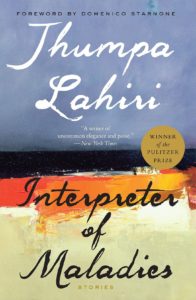 This work is a collection of short stories, and all of them focus on characters of Indian descent. Many of the stories take place in the Boston area while others are elsewhere, including a couple in India. And while each story is different, there are common themes underlying several stories including relationships between husband and wife, brief windows into immigrant life in the US, and the mistreatment of women. One story looks into a not so typical decline of a marriage followed by a rekindling made possible by a power outage. Another story involves a white child being babysat by a recent immigrant women whose husband is a professor. Yet another story concerns the revealing of a secret by a wife to her tourism guide. And there’s plenty more. This book reminded me a lot of a previous read of short stories, “Men Without Women” by Haruki Murakami with regard to the build up and length of the stories as well as the ease of reading the interesting tales. And while some stories here felt like they cut off a but too quickly (like nearly every one of the Murakami stories), a handful closed in a thankfully more satisfactory manner. Overall this is a great read and a quick one too.
This work is a collection of short stories, and all of them focus on characters of Indian descent. Many of the stories take place in the Boston area while others are elsewhere, including a couple in India. And while each story is different, there are common themes underlying several stories including relationships between husband and wife, brief windows into immigrant life in the US, and the mistreatment of women. One story looks into a not so typical decline of a marriage followed by a rekindling made possible by a power outage. Another story involves a white child being babysat by a recent immigrant women whose husband is a professor. Yet another story concerns the revealing of a secret by a wife to her tourism guide. And there’s plenty more. This book reminded me a lot of a previous read of short stories, “Men Without Women” by Haruki Murakami with regard to the build up and length of the stories as well as the ease of reading the interesting tales. And while some stories here felt like they cut off a but too quickly (like nearly every one of the Murakami stories), a handful closed in a thankfully more satisfactory manner. Overall this is a great read and a quick one too.
26 Marathons: What I’ve Learned About Faith, Identity, Running, and Life From Each Marathon I’ve Run, by Meb Keflezighi
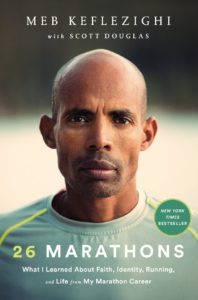 Meb, an American icon, has represented well in marathons and in this book he speaks about each of the 26 marathons he competed in. With a chapter for each one of his marathons, I was a bit concerned that the material would get dry and repetitive but thankfully that turned out not to be the case, as each chapter also included racing lessons, his training plan, and other interesting background leading up to each race. It was interesting to see how his training and race day strategies changed as he aged – and he’s worth listening to given that he won the Boston Marathon at almost 39. And I loved reading about how sponsorship rules factored into his racing decisions. As a marathon and ultramarathon skater, I was pleasantly surprised to find that quite a lot of the circumstances I’ve seen in inline speed skating marathons are present in marathon running too. Like drafting and sticking with a pack has quite an effect. And as a result, surges and attacks play a key role in race strategy. Less unexpected is that race day is always full of surprises, as you never know who’s not gonna be feeling their best (including oneself) and other conditions can shift things quite a bit. And as a distance athlete, there was a lot to learn from Meb. Like that one makes the most gains with consistent training over time with plenty of recovery rather than extreme efforts, and that this builds a body that can sustain performance even with missed training due to injury. And it seems doing a multitude of disciplines plays a key role in training, as Meb participated in plenty of shorter races interspersed between marathons. Overall this piece is inspirational and given all the challenges, setbacks, and missed goals faced by Meb over his career, only for him to come back and take the top, it’s a testament to keep propelling oneself forward.
Meb, an American icon, has represented well in marathons and in this book he speaks about each of the 26 marathons he competed in. With a chapter for each one of his marathons, I was a bit concerned that the material would get dry and repetitive but thankfully that turned out not to be the case, as each chapter also included racing lessons, his training plan, and other interesting background leading up to each race. It was interesting to see how his training and race day strategies changed as he aged – and he’s worth listening to given that he won the Boston Marathon at almost 39. And I loved reading about how sponsorship rules factored into his racing decisions. As a marathon and ultramarathon skater, I was pleasantly surprised to find that quite a lot of the circumstances I’ve seen in inline speed skating marathons are present in marathon running too. Like drafting and sticking with a pack has quite an effect. And as a result, surges and attacks play a key role in race strategy. Less unexpected is that race day is always full of surprises, as you never know who’s not gonna be feeling their best (including oneself) and other conditions can shift things quite a bit. And as a distance athlete, there was a lot to learn from Meb. Like that one makes the most gains with consistent training over time with plenty of recovery rather than extreme efforts, and that this builds a body that can sustain performance even with missed training due to injury. And it seems doing a multitude of disciplines plays a key role in training, as Meb participated in plenty of shorter races interspersed between marathons. Overall this piece is inspirational and given all the challenges, setbacks, and missed goals faced by Meb over his career, only for him to come back and take the top, it’s a testament to keep propelling oneself forward.